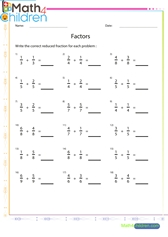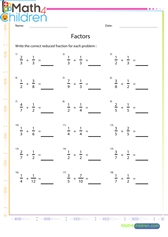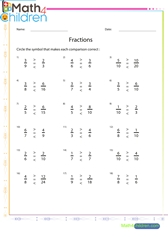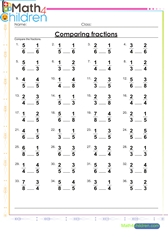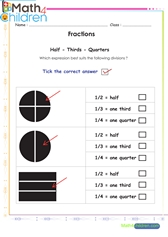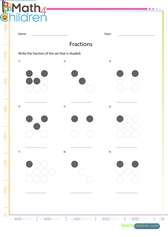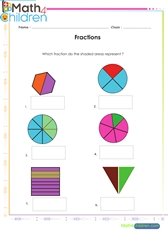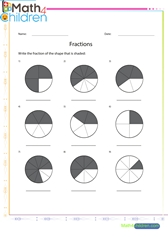![]()
Multiplying Fractions by Whole Numbers
Multiplying fractions by whole numbers is a fundamental operation in mathematics. It allows us to find the product of a fraction and a whole number, resulting in a new fraction or a whole number. This concept is essential in various real-life situations, such as scaling recipes, calculating distances, and determining proportions. In this article, we will explore the process of multiplying fractions by whole numbers, discuss strategies to simplify the calculations, and highlight some practical applications.
Game on Multiplying Fractions
Fractions shown with circles squares
Fractions shown with circles squares printable math worksheet
2. Understanding Fractions and Whole Numbers
Before diving into multiplying fractions by whole numbers, let's briefly review what fractions and whole numbers are.
A fraction represents a part of a whole or a division of a quantity into equal parts. It consists of a numerator (the top number) and a denominator (the bottom number), separated by a fraction bar. The numerator represents the number of parts we have, while the denominator represents the total number of equal parts in the whole.
On the other hand, whole numbers are the numbers we use to count whole objects or entities. They do not contain any fractional or decimal parts. Whole numbers include natural numbers (positive integers) and zero.
3. Multiplying a Fraction by a Whole Number
To multiply a fraction by a whole number, we can follow a simple procedure:
- Multiply the numerator of the fraction by the whole number.
- Keep the denominator of the fraction unchanged.
Let's take an example to illustrate this process more clearly.
4. Example Problems
Example 1: Consider the fraction 3/4 and the whole number 5. To find the product, we multiply the numerator (3) by the whole number (5) and keep the denominator (4) unchanged.
scss3/4 * 5 = (3 * 5) / 4 = 15/4
The result is the fraction 15/4.
Example 2: Let's try another example. Suppose we have the fraction 2/3 and the whole number 7.
scss2/3 * 7 = (2 * 7) / 3 = 14/3
The result is the fraction 14/3.
5. Strategies for Multiplying Fractions by Whole Numbers
While multiplying fractions by whole numbers, we can use a few strategies to simplify the calculations and obtain the result more efficiently:
Strategy 1: Convert the Whole Number to a Fraction To simplify the multiplication, we can convert the whole number into a fraction by placing it over 1. This allows us to work with two fractions instead of a fraction and a whole number.
Strategy 2: Simplify the Result After multiplying the numerator and the whole number, we can simplify the resulting fraction by reducing it to its simplest form. This involves finding the greatest common divisor (GCD) of the numerator and the denominator and dividing both by it.
6. Simplifying Fractions
Simplifying fractions is an important step in mathematics. It involves reducing a fraction to its simplest form by dividing both the numerator and the denominator by their greatest common divisor (GCD). Simplifying fractions helps us work with smaller numbers and makes calculations easier.
7. Common Mistakes to Avoid
When multiplying fractions by whole numbers, it's essential to be aware of some common mistakes and avoid them:
Mistake 1: Forgetting to Simplify Always remember to simplify the resulting fraction if possible. Leaving it in its simplest form ensures clarity and accuracy in calculations.
Mistake 2: Multiplying the Denominators When multiplying fractions by whole numbers, it is incorrect to multiply the denominators together. Instead, only the numerators and the whole numbers should be multiplied.
8. Real-Life Applications
Multiplying fractions by whole numbers has practical applications in various real-life scenarios. Some examples include:
-
Scaling Recipes: When adjusting the quantity of ingredients in a recipe, multiplying fractions by whole numbers helps maintain the correct proportions.
-
Determining Distances: Fractional distances can be multiplied by whole numbers to find the total distance covered or remaining.
-
Calculating Proportions: When working with ratios or proportions, multiplying fractions by whole numbers allows us to find the corresponding quantities accurately.
9. Conclusion
Multiplying fractions by whole numbers is a valuable skill that finds application in many aspects of everyday life. By following the simple procedure of multiplying the numerator and keeping the denominator unchanged, we can determine the product efficiently. Understanding the strategies to simplify fractions and avoiding common mistakes further enhances our ability to work with these mathematical operations. Remember to always simplify the result and consider real-life situations where this concept is useful.
10. FAQs
Q1: Can I multiply a fraction by any whole number? A1: Yes, you can multiply a fraction by any whole number. The procedure remains the same regardless of the value of the whole number.
Q2: Do I need to simplify the resulting fraction? A2: It is recommended to simplify the resulting fraction to its simplest form. However, in some cases, the fraction may already be in its simplest form.
Q3: Can I multiply a fraction by a negative whole number? A3: Yes, you can multiply a fraction by a negative whole number. The result will have a negative sign indicating a negative value.
Q4: Are there situations where multiplying fractions by whole numbers is not applicable? A4: Multiplying fractions by whole numbers is a widely applicable concept. However, its relevance may vary depending on the specific problem or situation.
Q5: How can I practice multiplying fractions by whole numbers? A5: You can practice multiplying fractions by whole numbers by solving various problems and exercises available in math textbooks, online resources, or educational apps.
Conclusion
In conclusion, multiplying fractions by whole numbers is a fundamental operation that allows us to calculate accurate results in various real-life situations. By following the outlined procedure and utilizing strategies for simplification, you can confidently solve problems involving fractions and whole numbers.

